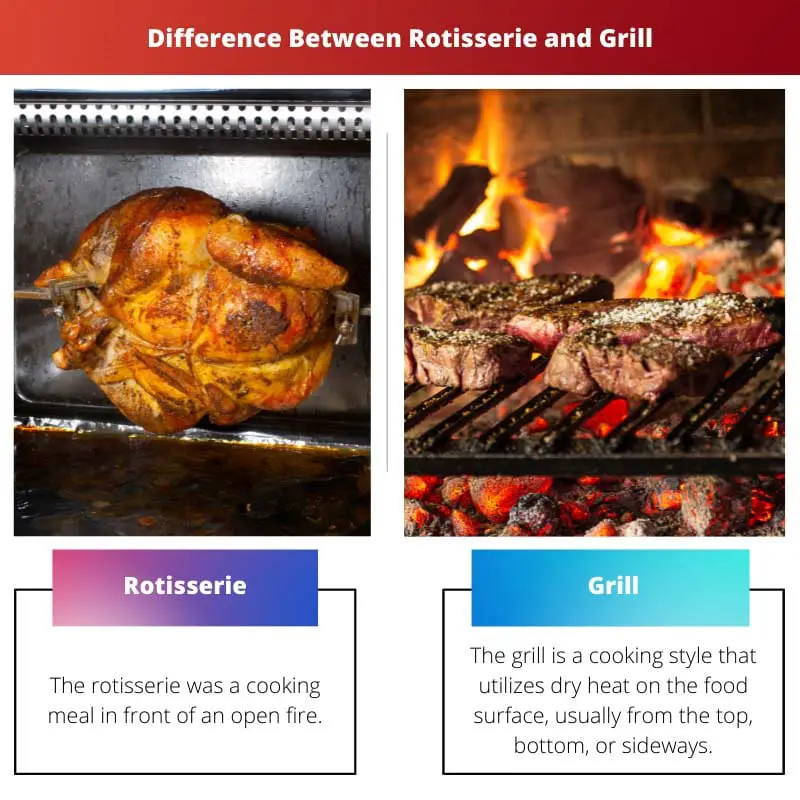History tells us that millions of years ago, people cooked meat and food over an open fire, which we call grilling and roasting, when nothing was known as a civilization! Barbecuing and Rotisserie are two closely linked ideas, although, in certain respects, the two processes vary.
Health experts largely recognize both approaches since they prepare the meal using indirect heat. Did you ever wonder what the distinctions are?
We will tell you a few essential differences which make barbecue and Rotisserie distinctive and different. But the strength of the heat utilized makes it ideal for thin cuttings like steaks, chops, and quarters of poultry.
The rotisserie can also lead to this amount of browning, but not so fast. Grill may also lower the amount of fat, particularly if the griller pan comes with a rack. Rotisserie takes occur at a slower speed so that larger pieces may be cooked without burning them on the outside or uncooked in the centre.
Key Takeaways
- A rotisserie is a cooking method where food is skewered on a spit and rotated slowly overheat, while a grill is a cooking method where food is placed on a grate over a heat source.
- Rotisserie cooking results in more even cooking and a juicier finished product, while grilling can result in a charred exterior and a drier interior.
- Rotisserie cooking is used for larger cuts of meat, such as whole chickens or roasts, while grilling is suitable for a wide range of foods, including vegetables, seafood, and smaller cuts of meat.
Rotisserie vs Grill
Rotisserie is a method of cooking meat that is pierced with a long rod and cooked on an open fire or roasted in an oven. It evenly cooks the meat to make it juicy with a crispy skin. Grill is a style of cooking that uses dry heat to cook meat or vegetables quickly. It uses a direct source of heat like charcoal or ceramic briquettes.

The rotisserie was a cooking meal in front of an open fire. But the Rotisserie process also altered with the development of the oven. Rotisserie is currently roasting food over a predetermined temperature in an isolated box.
The box uses warm air and cooks the meat until the meat fluids are dried to perfection.
The grill is a way of cooking on a flame of carbon. This was one of the first ways of cooking food. The food is put on an open flame grill rack, and the meat is broken and cooked properly with high heat.
Many people believe the approach to be more appropriate because of the additional health element and also does not need an oven, and almost everything may be grilled.
Comparison Table
| Parameters of Comparison | Rotisserie | Grill |
|---|---|---|
| Meaning | The rotisserie was a cooking meal in front of an open fire. | The grill is a cooking style that utilizes dry heat on the food surface, from the top, bottom, or sideways. |
| Invented | Dan Okrent | Henry Ford |
| Year | 1450 | 17th century |
| Origin | French | South America |
| Type | Cooking | Dry heating |
What is Rotisserie?
Rotisserie is a type of Rotisserie that spits on meat – a solid rod that is used to hold food, grilled over a fire in the fireplace or a campfire, or roasted in an oven.
Rotisserie is also known as spit-Rotisserie. This method is used to prepare big joints, such as pigs and turkeys, of meat or whole animals. The rotation evenly cooks the meat in its juices and makes continual grinding easy to access.
The spit was the favoured technique to prepare meat in a large family in Medieval and early modern cuisines. A servant, ideally a child, sat at the spit, turning the metal bucket gently and cooking the meal.
Mechanical turnspits were later created, initially driven by dogs on treadmills, then by steam power and mechanical clockwork mechanisms. They were then invented. A turbine placed in the chimney with a worm transmission for torque and speed conversion might be used to power the spit.
Spit powered by electric motors is becoming common. Rotisserie may be a rotisserie mechanical appliance or a restaurant specialising in meat Rotisserie.
The word was derived from French and was first found in stores in Paris about 1450. The rotisserie is also responsible for all spit-roasted, grilled bakers and, in some cases, fried meals in restaurants utilizing the Escoffier Ian culinary brigade.
[amazon bestseller=”Rotisserie” items=”2″ template=”table”]

What is Grill?
The grill is a cooking style that utilizes dry heat on the food surface, from the top, bottom, or sideways. Grilling includes a considerable quantity of direct radiant heat and is frequently used rapidly for cooking meat and vegetables.
The food to be prepared is cooked on a grill using an iron cast/frying pan (similar to a frying pan, but with raised ridges to mimic the wires of an open grill). Heat transmission to the food is mostly through thermal radiation when a grill is used.
Heat transmission is through direct driving when utilizing a grill or grid. In the United States, grilling is termed grilling when the grill heat source is from above. In this instance, the pan holding the food is called a grilling pan, and the heat transmission occurs via thermal radiation.
Grilled meat obtains a characteristic roast fragrance and flavour through a chemical process known as the reaction of Maillard. Maillard reaction is only possible if food is over 155°C (310°F).
Studies have indicated that the production of heterocyclic amines, benzopyrene, and polycyclic aromatic hydrocarbons, which are carcinogenic, might lead to cooking beef, pig, chicken, and fish at a high temperature.
The development of these chemicals can be reduced by margination. A grill is frequently a healthy option for oils when grilling fat and fluids may add to the drier food. Grilling is an alternative to oils.
[amazon bestseller=”Grill” items=”2″ template=”table”]

Main Differences Between Rotisserie and Grill
- Rotisserie cooking techniques are stewing and frying, whereas grill cooking techniques are baking and barbeque.
- Rotisserie is wet heating, whereas grill is dry heating.
- Rotisserie came into existence in 1450, whereas grill came into existence in the 17th century.
- Rotisserie is cooking on an open fire, whereas a grill is done with raised ridges to mimic the wires of an open grill.
- Rotisserie is done for the whole meat, whereas grill is done on top and bottom.

The historical and cultural insights pertaining to the origins of rotisserie and grill cooking are engaging and insightful. Understanding the context in which these methods developed enriches the appreciation of culinary traditions.
I found it quite intriguing that the rotisserie cooking method was originally done in front of an open fire. The historical context of these cooking techniques is just as captivating as the comparison itself.
It’s truly amazing how these ancient cooking methods have evolved over time and are still used today in various forms, from open flames to modern electric rotisseries. The innovation in cooking is truly inspiring.
The comprehensive description of rotisserie and grill cooking, along with the historical background and technological advancements, provides a holistic view of these culinary methods. This article presents a well-rounded exploration of the topic.
I couldn’t agree more. The depth of information about the historical, technical, and cultural aspects of these cooking methods facilitates a comprehensive understanding of their significance in culinary practices.
Absolutely, the multifaceted analysis of rotisserie and grill cooking serves as a valuable resource for individuals interested in the evolution of food preparation techniques.
The information provided in this article about the origins, cooking processes, and modern usage of rotisserie and grill cooking is comprehensive and enlightening. Understanding the differences in these culinary methods is crucial for chefs and cooking enthusiasts.
I couldn’t agree more. The historical evolution of cooking techniques and the impact of modern technology on these methods reveal the richness and complexity of culinary traditions across cultures.
The comparison table offers a clear and concise breakdown of the differences between rotisserie and grill cooking. This kind of detailed analysis is beneficial for anyone looking to expand their knowledge of cooking methods.
The technical details about the cooking methods of rotisserie and grill offer valuable insights for anyone interested in the art of cooking. The practical differences and their impact on the texture and flavor of food are truly enlightening.
I completely agree. The scientific and culinary aspects discussed in this article contribute to a broader understanding of the principles behind effective cooking techniques.
The detailed explanation of the mechanical evolution of rotisserie cooking, from manual to electric, is an interesting addition to the comparison. The historical context of these culinary traditions adds depth to the subject.
The detailed explanations and historical contexts provided in the article impart a profound understanding of the traditions associated with rotisserie and grill cooking. The depth of analysis is commendable.
Absolutely, the article’s comprehensive exploration of rotisserie and grill cooking includes historical, cultural, and practical insights, providing a well-rounded understanding of these culinary methods.
The meticulous examination of both the historical and technical aspects of rotisserie and grill cooking reflects the thoroughness of the content. It’s a valuable resource for culinary enthusiasts.
The distinctions between barbecue and Rotisserie are fascinating. Their differences in cooking methods are incredibly informative and useful for anyone interested in preparing food in various ways.
The distinction between rotisserie and grilling in terms of their historical origins and cultural significance is a valuable aspect of the article. Understanding the cultural contexts of these cooking methods enhances appreciation for their culinary heritage.
Absolutely. Exploring the cultural and historical foundations of cooking techniques enriches our understanding of the diverse culinary practices that have shaped cuisines around the world.
The inclusion of the comparison table provides a clear, organized breakdown of the essential differences between rotisserie and grill cooking. This visual aid enhances the understanding of the topic.
Definitely. The visual representation of the information supports the clarity and accessibility of the content. It’s a great resource for anyone seeking a quick reference on these cooking methods.